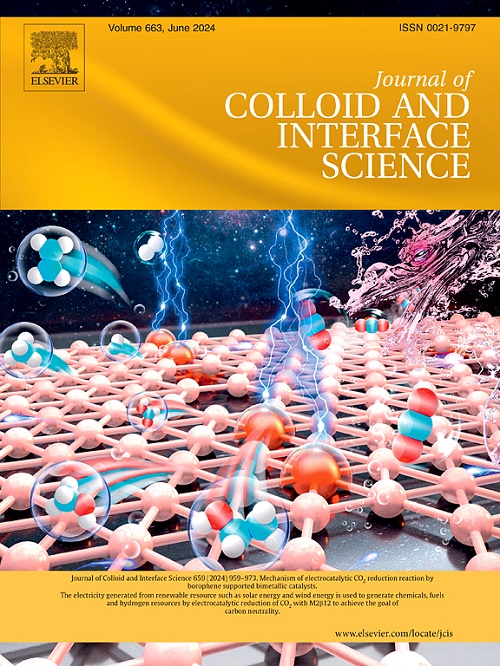Graphene-like MoS2/C sandwiched-structures for kinetic acceleration of polysulfide conversion in LiS batteries
IF 9.7
1区 化学
Q1 CHEMISTRY, PHYSICAL
引用次数: 0
Abstract
Graphene-like MoS2/C composites with sandwiched-structures have been fabricated through a facile hydrothermal process and subsequent annealing treatment, which are used to modify separators for Li![]() S batteries. The sandwiched carbons could not only generate fast electronic conducting channels between MoS2 layers to endow MoS2/C with high conductivity, but also prevent MoS2 layers from re-stacking to obtain few- or single-layered MoS2 with large amounts of active-sites for polysulfide adsorption and electro-catalysis. Therefore, the MoS2/C composites could effectively promote the polysulfide conversion and Li2S deposition, and the MoS2/C modified polypropylene (MoS2/C@PP) separators could greatly prohibit the polysulfide shuttling to enhance the electrochemical performances of Li
S batteries. The sandwiched carbons could not only generate fast electronic conducting channels between MoS2 layers to endow MoS2/C with high conductivity, but also prevent MoS2 layers from re-stacking to obtain few- or single-layered MoS2 with large amounts of active-sites for polysulfide adsorption and electro-catalysis. Therefore, the MoS2/C composites could effectively promote the polysulfide conversion and Li2S deposition, and the MoS2/C modified polypropylene (MoS2/C@PP) separators could greatly prohibit the polysulfide shuttling to enhance the electrochemical performances of Li![]() S batteries. The Li
S batteries. The Li![]() S batteries equipped with MoS2/C-3@PP separators at an optimized MoS2 content deliver a high reversible capacity of 1262 mAh g−1 at the 1st cycle and outstanding cycling stability with 791, 763 and 722 mAh g−1 after 100 cycles at 0.2C, 0.5C and 1C, respectively. Furthermore, the MoS2/C-3@PP separators could help the Li
S batteries equipped with MoS2/C-3@PP separators at an optimized MoS2 content deliver a high reversible capacity of 1262 mAh g−1 at the 1st cycle and outstanding cycling stability with 791, 763 and 722 mAh g−1 after 100 cycles at 0.2C, 0.5C and 1C, respectively. Furthermore, the MoS2/C-3@PP separators could help the Li![]() S pouch cells possessing high-areal-loading S/C cathodes and lean electrolytes to exhibit better electrochemical performances. These encouraging results suggest that the sandwich-structured composites constructed by graphene-like transition-metal dichalcogenides (TMDs) and carbon layers could be a type of promising catalyst for advanced Li
S pouch cells possessing high-areal-loading S/C cathodes and lean electrolytes to exhibit better electrochemical performances. These encouraging results suggest that the sandwich-structured composites constructed by graphene-like transition-metal dichalcogenides (TMDs) and carbon layers could be a type of promising catalyst for advanced Li![]() S batteries.
S batteries.

石墨烯类MoS2/C夹层结构对锂离子电池中多硫化物转化的动力学加速
通过简单的水热法和随后的退火处理,制备了具有三明治结构的类石墨烯MoS2/C复合材料,用于改性锂离子电池的隔板。夹碳不仅可以在MoS2层之间形成快速的电子导电通道,使MoS2/C具有高导电性,而且可以防止MoS2层重新堆叠,获得具有大量活性位点的多层或单层MoS2,用于多硫化物吸附和电催化。因此,MoS2/C复合材料可以有效地促进多硫化物的转化和Li2S的沉积,而MoS2/C改性聚丙烯(MoS2/C@PP)隔膜可以极大地阻止多硫化物的穿梭,从而提高锂离子电池的电化学性能。在优化的MoS2含量下,配备MoS2/C-3@PP分离器的锂离子电池在第一次循环时具有1262 mAh g - 1的高可逆容量,在0.2C, 0.5C和1C下循环100次后分别具有791,763和722 mAh g - 1的出色循环稳定性。此外,MoS2/C-3@PP隔膜可以帮助具有高面积负载S/C阴极和贫电解质的锂离子袋状电池表现出更好的电化学性能。这些令人鼓舞的结果表明,由石墨烯类过渡金属二硫族化合物(TMDs)和碳层构成的三明治结构复合材料可能是一种有前途的先进锂电池催化剂。
本文章由计算机程序翻译,如有差异,请以英文原文为准。
求助全文
约1分钟内获得全文
求助全文
来源期刊
CiteScore
16.10
自引率
7.10%
发文量
2568
审稿时长
2 months
期刊介绍:
The Journal of Colloid and Interface Science publishes original research findings on the fundamental principles of colloid and interface science, as well as innovative applications in various fields. The criteria for publication include impact, quality, novelty, and originality.
Emphasis:
The journal emphasizes fundamental scientific innovation within the following categories:
A.Colloidal Materials and Nanomaterials
B.Soft Colloidal and Self-Assembly Systems
C.Adsorption, Catalysis, and Electrochemistry
D.Interfacial Processes, Capillarity, and Wetting
E.Biomaterials and Nanomedicine
F.Energy Conversion and Storage, and Environmental Technologies

 求助内容:
求助内容: 应助结果提醒方式:
应助结果提醒方式:


